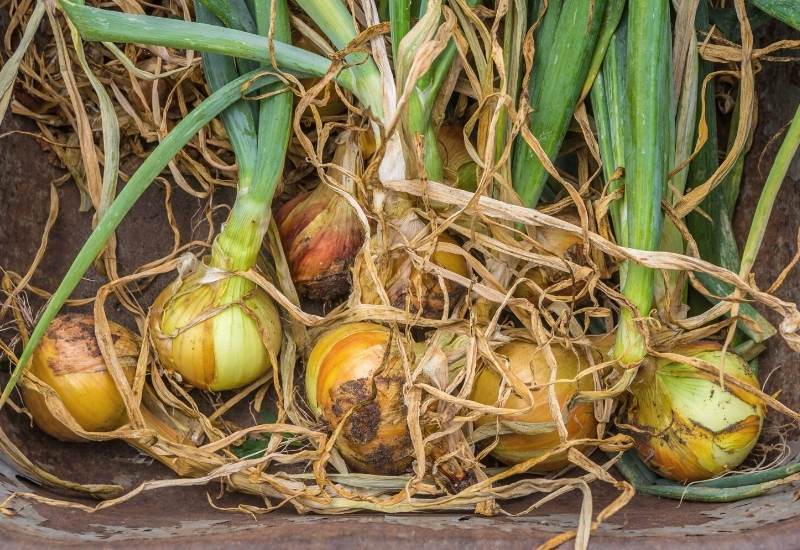
Onions are a staple of most kitchen gardens along with other members of the allium family like garlic and leeks.
Since the main harvest is found in the underground bulb, it can be difficult to accurately assess exactly when you should pull up your onions, and you don’t want to end up with premature, small bulbs or overripe rotting ones. Timing is everything, especially if you plan on curing your onions for storage.
How do you know when onions are ready to be picked?
In short, green onions should be harvested in the spring when the tops are still green, and mature onions bulbs should be harvested only once the leaves turn brown and fall over. Depending on your region and time of planting, this usually occurs around the end of summer or early fall. Onions will be ready for harvest approximately 90-150 days from planting seeds, depending on the variety being cultivated and weather conditions.
Since there are no hard calendar dates to follow when it comes to harvesting onions, you will need to rely on your senses and assessment skills to determine the perfect time to pull up your bulbs.
The Two Main Onion Harvests
Most varieties of onions can be grown and harvested as either green onions or mature onions. It’s a good idea to plant quite a few onion seeds or starts so that you can experience harvesting both types.
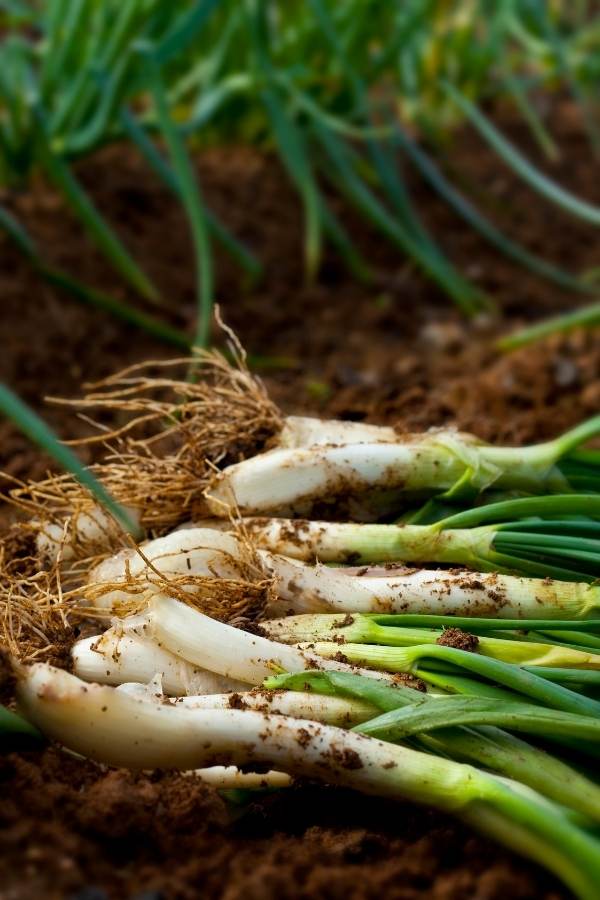
Green or ‘spring’ onions are essentially small, very premature onions that are harvested in the spring or early summer. They vaguely resemble a small, thin leek more than an onion with unformed white bulbs and tall green leaves.
Green onions, like mature onions, have no specific harvest date, but are generally pulled up between March and June depending on where you live and how big you want your spring onion to be.
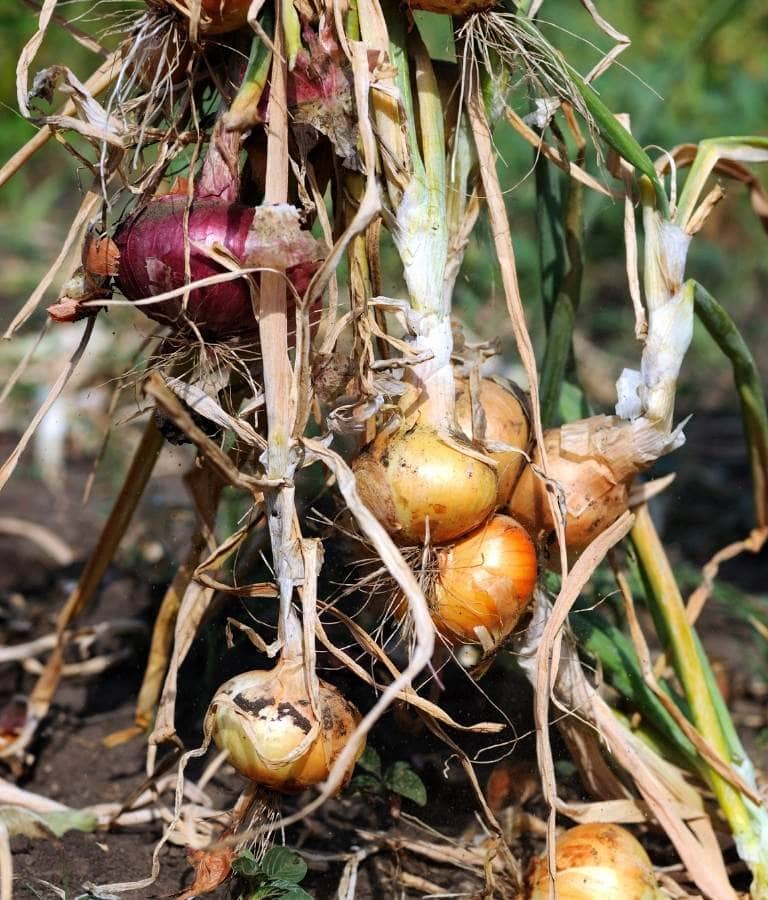
Mature, storage onions make up the main onion harvest in the late summer and early fall. You get more bang for your buck harvesting mature onions, as they are substantially larger than spring onions and can be stored for much longer since they are covered in a flaky skin.
You probably know what the most classic yellow and red onions look like, but there are many interesting cultivars that come in different shapes and colors.
How to Determine When Onions are ready for harvest
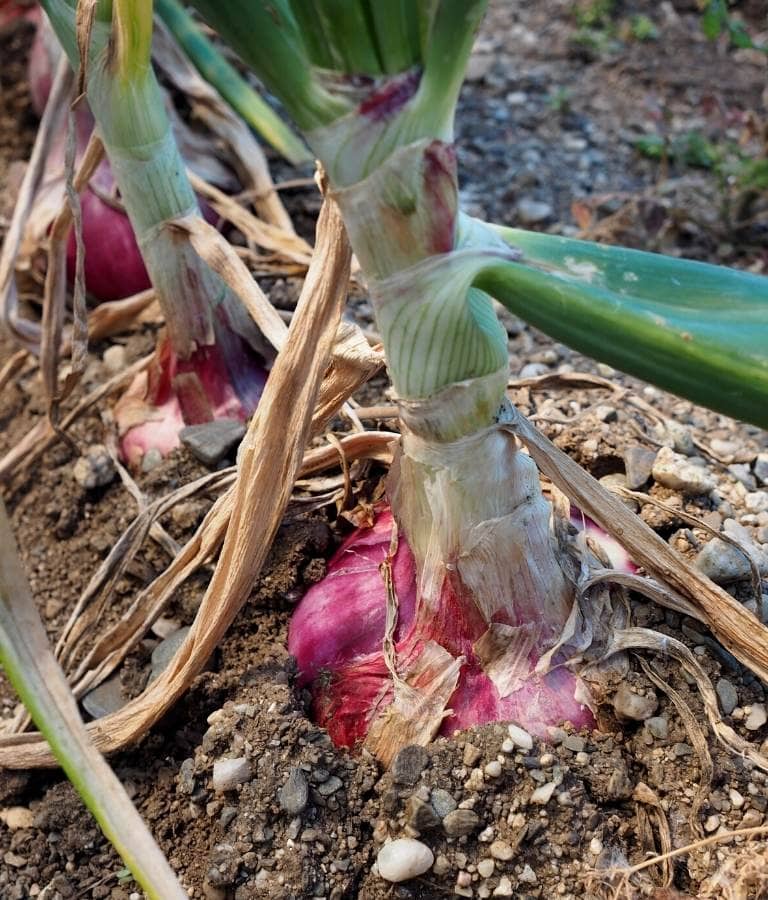
Harvesting mature onions is a bit more tricky than harvesting spring onions as the timing is more important once the onions have started to really develop a skin and fill out.
The best indicator to know if your onions are ready to harvest is the leaves, which will be green and puffy for most of the season while the bulbs are growing. When the onion bulbs are reaching peak maturity, the leaves will begin to turn yellow and wither a little, at which point you can actually roughly push down any leaves that are still standing and step on them.
This will hurry along the remaining ripening process so you can harvest your bulbs sooner. Whether or not you choose to do this, you will know your onions are mature and ready to be pulled when the tops are brown and flopped on the ground.
A few days before you anticipate harvesting, you can also loosen the soil around the bulbs with a pitchfork (very carefully!) to encourage them to dry out a little, and you should also stop watering them at this point.
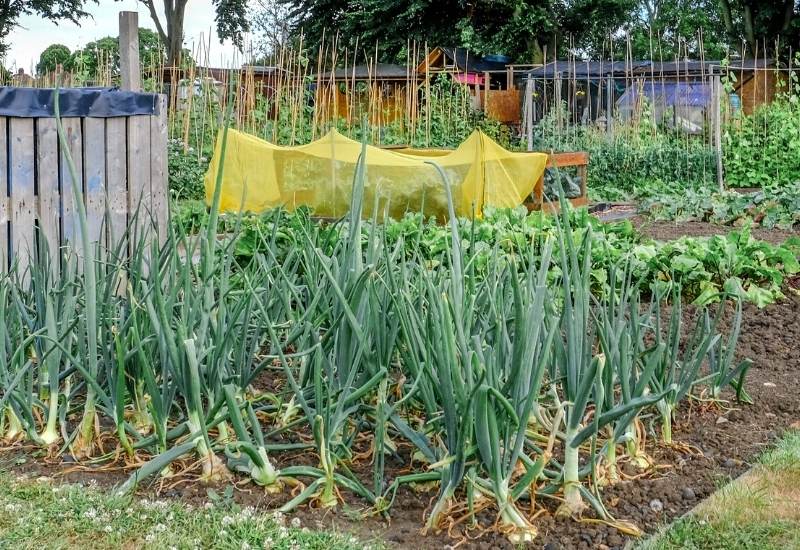
You should always do a spot harvest to make sure your bulbs are actually ready to be pulled by selecting a few random plants in your bed to pull.
Pull them from different areas to account for variability in growing conditions, and make sure they are the size you want them to be before harvesting all of your onions.
How to Harvest Storage Onions Step-by-Step
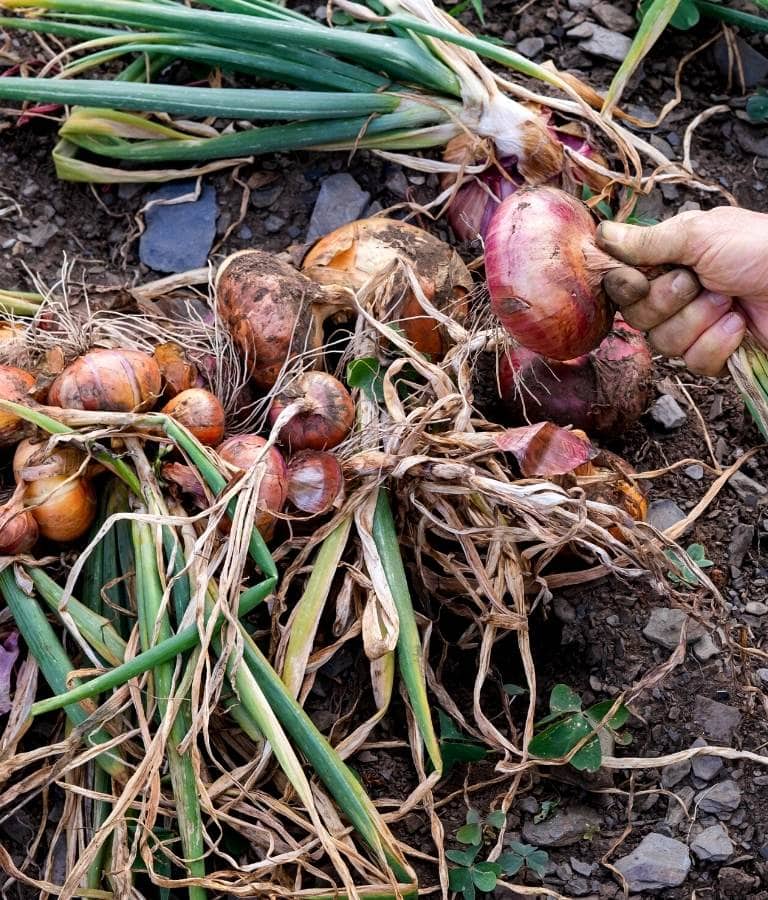
Once you have determined your onions are ready to be harvested the next step is to pull them up. This is not difficult to do, but the fresh bulbs are quite fragile and easily bruised so a certain amount of caution is needed.
Here is our guide to harvesting your mature bulbs broken down into the basic steps:
How to Cure Onions for Long-term Storage
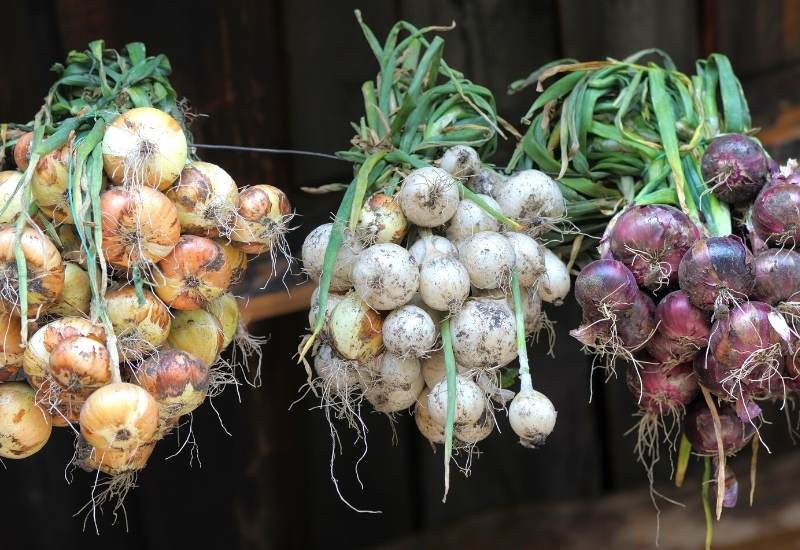
Curing is the process of drying out your onions so that they are well prepared for storage. Once your onions have been outside drying in the sun for a day or two, you should bring them to a more sheltered, dry area to finish curing.
The best location for curing is an area which is covered and dry but has great air flow to prevent any mold or rotting.
Farmers would use an open barn, but if you have a garage with good ventilation or a covered porch/patio that should work well.
The onions should be kept in the shade to prevent being burnt by sunlight, and they should never be exposed to moisture since the idea is to get them super dry!
Curing can take just a couple of weeks up to a month depending on how humid it is where you live. After a week or two of curing, you can trim away the roots and leaves so that you can see how each onion looks and which are the best candidates for storage.
To do this just take a sharp pair of scissors and cut down the roots so there’s just an inch of bristle at the bottom and snip off the leaves right at the base of the onion’s neck.
The trimmed roots make a great brush to remove any remaining dirt or loose flakes of skin from the other onions to tidy them up.
You will be able to tell that your onions are finished curing once their neck is dried out and the skin is papery and brown.
How and Where to Store Onions
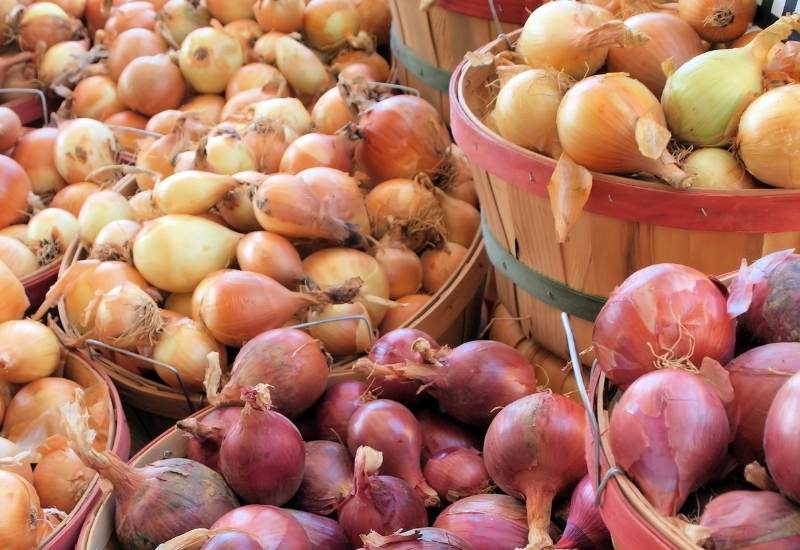
Once your onions are cured and completely dried out, you should store them for fall and winter use in a cool, dark, and dry location. You can keep them in a wicker basket or mesh bag, and a popular technique is to stack them in old stockings for hanging.
The key is to make sure they are kept in a breathable material that isn’t sealed off so that the onions remain dormant and do not sprout.
Storage temperatures should be between 35 and 55 ℉, and should never get any warmer than 70℉ or the bulbs will be compromised.
Onions should not be stored with sweet fruits (apples, bananas, pears) or potatoes, as the onion flavor may seep into them, and the gas produced by ripening fruits (called ethylene) will mess with the onions dormancy.
So-called pungent onions- the ones that make you cry- will store for much longer than sweet onions, even as long as a year if kept in optimal storage conditions.
The larger sweet onions will usually just keep for 3-5 months, so use those first to have a constant supply of storage onions until next season.
Small onions can be stored for planting the next spring, and can be kept in around the same conditions but on the cooler end of the temperature spectrum.
You should frequently check on your storage onions to make sure none of them are sprouting little green shoots, as this is a sign that conditions are too warm.
Sprouted onions should be used quickly before they go bad, as they won’t be able to sit in storage anymore.
Frequently Asked Questions
Can you eat onions right out of the ground?
Yes! Onions can be eaten fresh or after curing. Sweet onions are commonly eaten fresh since they don’t last that long in storage.
How long can you leave onions in the ground?
Once the tops have died back you should harvest your onions in the next one to two weeks to avoid bulbs rotting, especially if there is any rain forecasted.
Onions left in the ground will begin to decompose or become hosts for disease or pest pathogens (like onion maggots) and may even try to sprout again before winter.
Can you harvest onions after they flower?
Onions that have produced flowers or ‘bolted’ are not suitable for curing and long term storage, as the bulb development will have been halted and the plant’s energy directed toward flower and seed production.
Onions usually bolt due to some type of stress, and there is nothing that can be done once they have begun to flower. You can either leave the flowering plants to save onion seeds, or harvest them right away for fresh use since they are still perfectly edible.
What happens if you leave onions in the ground?
Onions left in the ground will begin to rot and become a magnet for onion flies to lay eggs and breed. If you accidentally rip off the leaves while harvesting an onion, you should make sure to dig up the bulb so that you don’t accidentally leave it in the soil.
Since any debris from onion plants will spread onion flies and maggots, you should clear all plant material from the bed at the end of the season.
What is the difference between short day and long day onions?
Different onion varieties are suited for different climates and how much daylight they will receive in a day.
Short day onions will set themselves up for bulb development when the days are 10-12 hours long, and long day varieties need around 14-16 hours of sunlight.
Short day varieties are usually sweeter and grown in southern regions, and long day ones are grown in the north, are pungent and are better suited for long-term storage.
What is the difference between pungent and sweet onions?
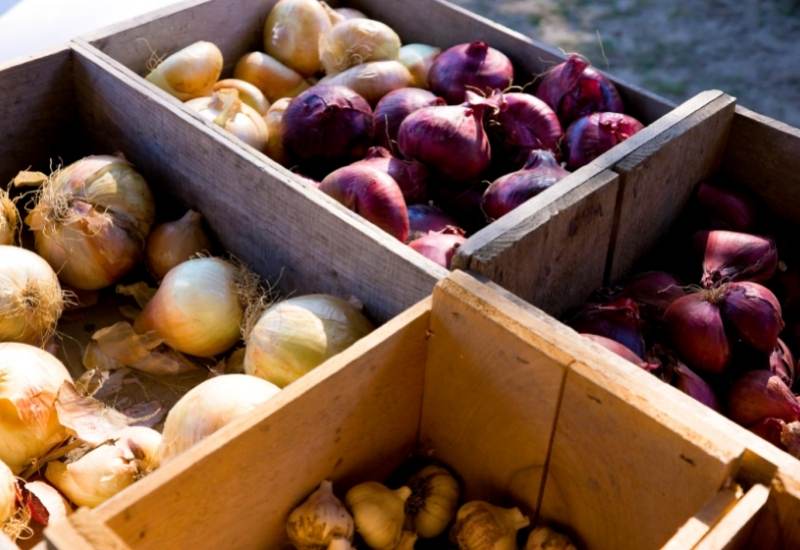
Related to whether they are short day or long day, onion pungency determines how well they can be stored. Pungent onions are usually smaller and have a sulphur-based chemical inside them which is what makes you tear up when chopping them.
This chemical prevents rotting which is why they can store longer. Sweet onions don’t have the same amount of these sulphuric secretions and therefore store for only a few months. Larger, short day varieties are usually- but not always- sweet onions.
There are also several day-neutral varieties that can be grown in most climates and are a good in-between onion with a slightly longer storage expectancy than short day varieties.
What are the best varieties of onion to grow?
See the above questions for distinctions between short day and long day/ pungent and sweet onions to make the most informed decision for your region and what you want to use your onions for.
‘Yellow Globe’, ‘First Edition’, ‘Red Wethersfield’, and ‘Yellow/White Spanish’ are popular long day onion varieties good for northern climates.
‘Red Burgundy’, ‘Southern Belle’, and ‘Red Creole’ are short day varieties suited for southern and sub-tropical climates.
How do I prevent onion maggots?
Onion maggots are infamously destructive to onion crops and can result in infected onions rotting in the ground or in storage. The best prevention for onion maggots is crop rotation to disrupt the breeding and life cycle of adult onion flies.
The maggots will overwinter and emerge in the late spring as flies and then lay eggs wherever they can find alliums (onions, garlic, leeks).
For this reason, all allium plant debris from the previous season should be completely cleared and disposed of in the fall, and nothing in that family should be replanted in the same bed for at least 2-3 years.
Once you plant seedlings, cover them with a floating row cover to prevent flies from laying eggs on young plants, and try to plant them late in the year.
Do I have to cure my onion harvest?
Nope! You do not have to cure all of your onions, only those that you plan on storing for use throughout the winter.
Onions can be eaten fresh out of the ground, and many people choose not to cure sweet onions at all since some varieties will only store well for a couple of months.

Written By
Maya
Maya is a freelance content writer and avid gardener currently based in Sweden. She gained her BA in Environment and Geography in Canada, which is also where she first learnt about the detriments of the industrialized agricultural system. During the summer she began farming through the WWOOF program, and over the next six years has continued to grow and learn at a number of organic farms and gardens across the US and Canada. She is passionate about the role of regenerative agriculture in wildlife conservation and climate change mitigation, and thinks growing your own food is a key part of revolutionizing the system. In her free time she likes to read, garden, and pet nice dogs.

I incorrectly followed the advice from the old farmers almanac that said after a day or two of drying outside that I could cut the tops off to and inch or two and the roots and cure them in a well ventilated area. We put them on a drying rack in the basement and only after a couple of days they are sprouting…..I’m so upset as they are beautiful big yellow onions that I hoped to store but now it would seem the ones that have sprouted will have to be eaten sooner rather than later…any advice? suggestions as to what I can do now? Thanks in advance!
If you had a few onions with flower stalks growing through the bulbs, use those up first. The flower stalks retain a lot of moisture (even after curing) and will cause the onions to decay quicker in storage. They’re perfectly fine to eat and usually keep for a month or so.
I’m 81 and have been growing garlic & onions for many years— your info is right on for new comers— Thank You.